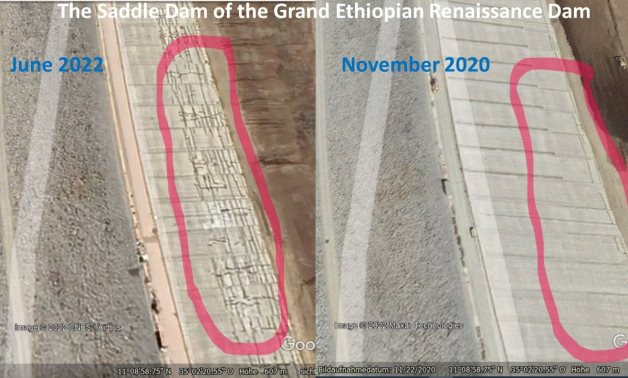
Google Maps images showing cracks in the saddle dam of the Grand Ethiopian Renaissance Dam – Photos acquired and posted by Professor Hani Sewilam
CAIRO – 5 July 2022: Academic Director of the Department of Engineering Hydrology at the RWTH Aachen University in Germany Hani Sewilam warned Monday of the presence of cracks in the body of the saddle dam of the Grand Ethiopian Renaissance Dam (GERD).
Sewilam made the observation through images he acquired on Google Maps, making a comparison between those of 2020 and others of 2022. He clarified that the danger lies in the fact that Ethiopia plans to use the saddle dam in holding 50 billion cubic meters of water.
The professor elaborated that the GERD's reservoir's initial capacity is just 18.5 billion cubic meters, and that what makes the entire project's capacity 74 billion cubic meters is the saddle dam located away from the main body.
Sewilam underlined that he could not confirm or cancel out the probability of the dam's collapse. Yet, he demanded Ethiopia and the Italian company implementing the project to release a press statement, clarifying the status of those cracks and displaying the relevant technical studies.
The professor also called on the international community and human rights organizations to intervene for suspending constructions and filling at the GERD, inhibiting probable risks.
Further, Professor of Geology and Water Resources at Cairo University Abbas Sharaqy pointed out that the third filling of the GERD had not begun yet, estimating that it would take place between July 10 and August 5 with five billion cubic meters.
The first filling of the GERD took place on July 1- 21, 2020 with 4.9 billion cubic meters, while the second was carried out on July 4 – 18, 2021 with around three billion cubic meters.
Sharaqi explained that two billion cubic meters have been released over the past three months by opening two gates. He added that the quantity of water held in the reservoir would reach the levels of 2021, becoming eight billion cubic meters again, next week, before more is added.
The professor acquired his information by comparing satellite images of the present with others of August 2021, confirming that the capacity of the GERD's reservoir, designed in the 1960s, has been enlarged because of the saddle dam.
In a TV interview with Al Arabiyah in May, General Manager of the Grand Ethiopian Renaissance Dam (GERD) Kifle Horo confirmed the fears of Egypt and Sudan about the absence of a legally binding agreement that regulates the filling of the reservoir in time of drought and severe drought.
Horo said that, during heavy rains, water would overflow in the direction of the two downstream countries. "As for drought durations, the water flowing into the reservoir will remain in the dam. That is the regular way of filling in such projects," the GERD general manager stated.
The Ethiopian official added that the second Turbine would be installed in a few weeks, and that the total capacity of the dam would reach 5,150 megawatts when all 13 turbines are put in place. As such, the amount of electricity produced by the dam would be 15,760 gigawatts.
The dispute among Egypt, Sudan, and Ethiopia dates back to May 2011 when Ethiopia started building the dam; Egypt voiced concern over its water share [55.5 billion cubic meters].
Constructions in the Grand Renaissance Dam started on April 2, 2011 at a cost of $4.8 billion. It was built by the Italian construction and engineering company Salini Impergilo. The dam is located on the Blue Nile with a planned reservoir capacity of 74 billion cubic meters, and was expected to generate up to 6,000 megawatts of power.
However, it is estimated to generate only 3,000 megawatts, as the number of turbines to be installed has been reduced to 13 turbines down from 16.
On January 13, Ethiopia declared it would begin removing 17,000 hectares of forests in February, which would take 60 days, to make possible conducting the third filling of the dam.
Comments
Leave a Comment